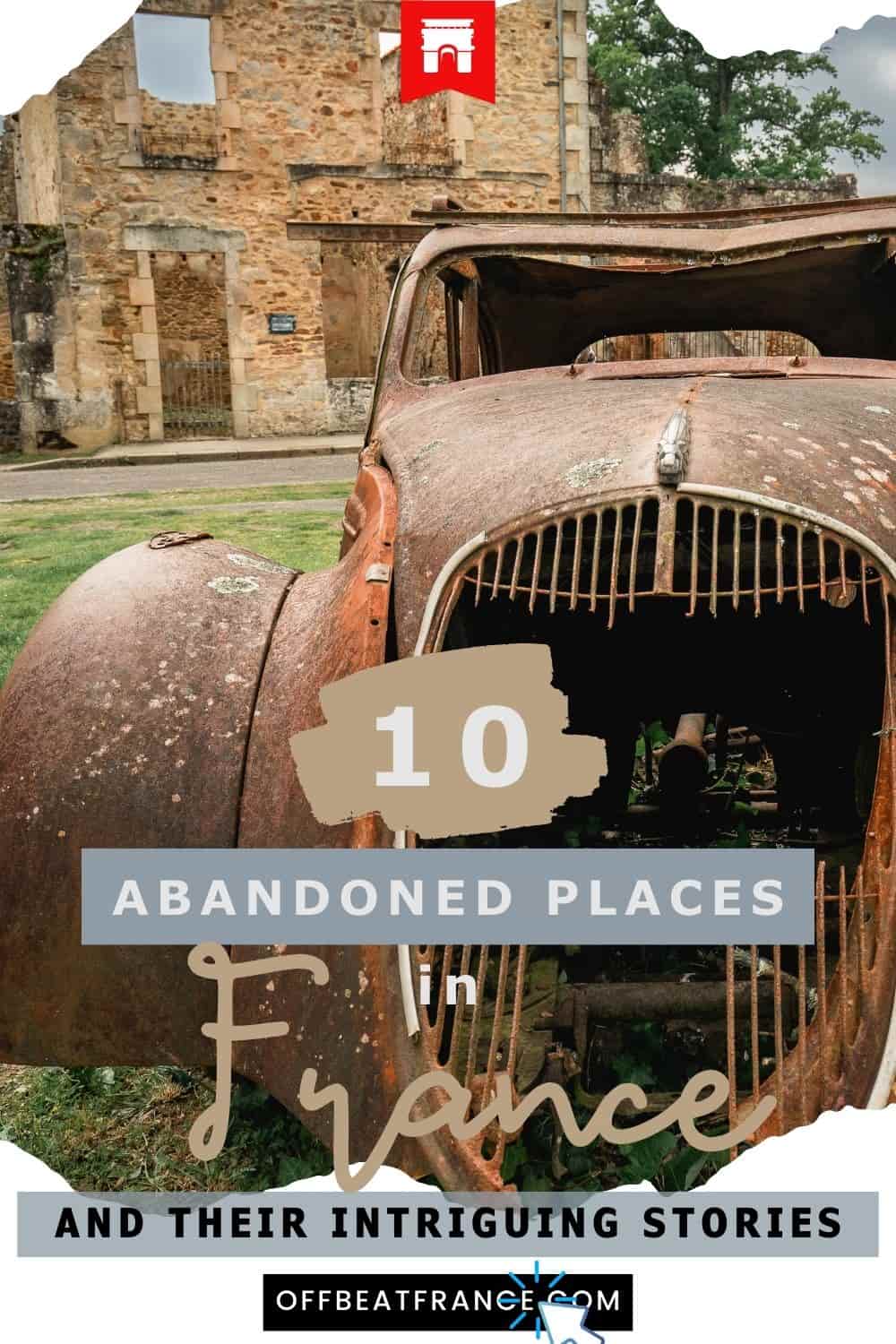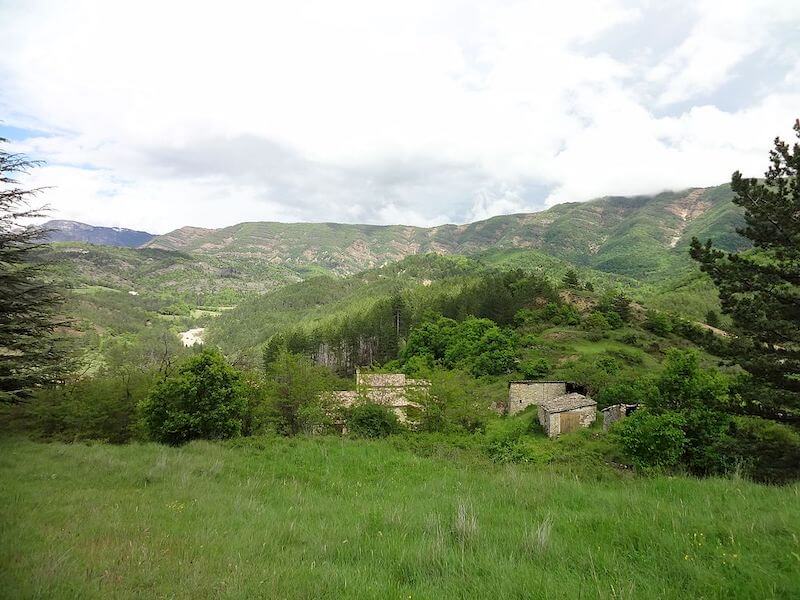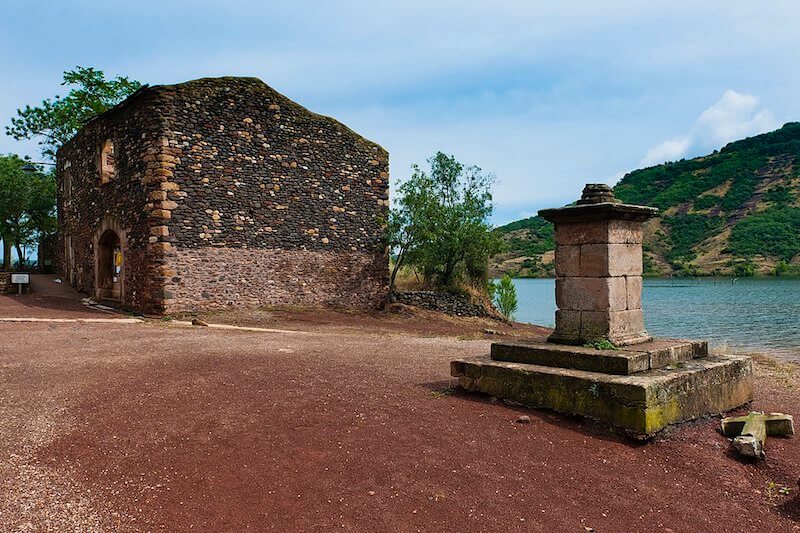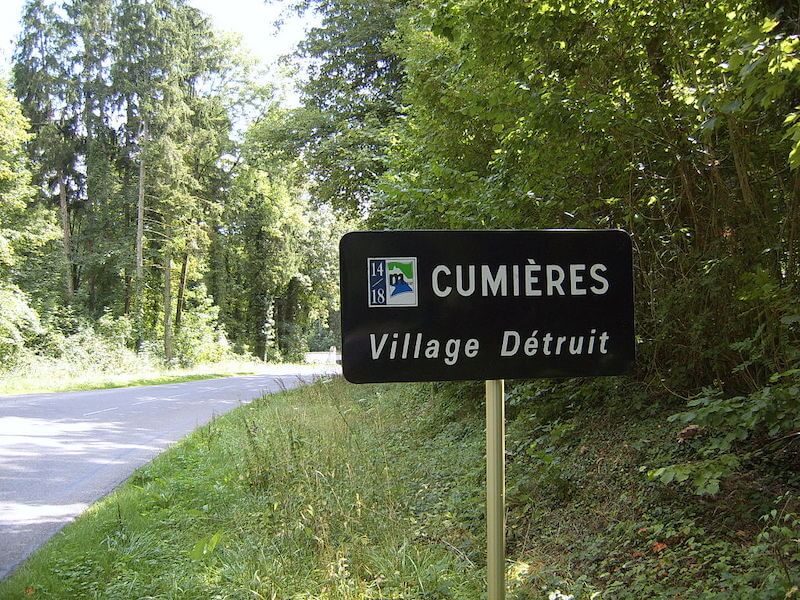Unsure about your French table manners? Click Here to download > > How to avoid these 10 food etiquette mistakes !
- Home ›
- Destinations ›
- Abandoned Places
The Intriguing Stories of Abandoned Places in France
Published 21 February 2021 by Leyla Alyanak — Parisian by birth, Lyonnaise by adoption, historian by passion
France is an old country and many places have been abandoned as people move away, or are forced to move by war or natural disaster. Here are a few of France's more famous ones.
NOTE: Pages on this site may contain affiliate links, which bring in a small commission at no cost to you.
Why would anyone want to visit abandoned places in France?
Because they are living history, a tangible memory of tragedy and horrors past, events we must remember, if only never to repeat them again.
Why did these places, once thriving, empty out? Mostly because of war, displacement for development or disease. And sometimes, nearly unspeakable tragedy.
Walking through abandoned streets and buildings can be chilling, the heavy memories of the past clinging to sidewalks and walls.
Yet we perversely rejoice in that thrill, not because we like it but because we are thirsty for historical significance, have a biochemical reaction to the lingering darkness, or because of simple curiosity.
France, so filled with historical places, is bound to have a multitude of these.
Oradour-sur-Glane: wanton destruction or planned terror?
Any exploration of abandoned villages in France would have to start here, in Oradour-sur-Glane, in the lush, rolling countryside of the Haute-Vienne.
It was 10 June 1944, four days after the Allied landing in Normandy.
An elite group of soldiers stationed in southern France, the SS Panzer Division Das Reich, set out northwards. Its mission was to destroy the ongoing Resistance.
Made up of veterans of the Eastern Front, they were no strangers to violence or brutality or terror.
Suddenly, in the quiet heat of early afternoon, the sound of motors broke the heavy air of Oradour. The Division's Das Reich battalion first circled the village, and then rounded up its inhabitants on the main square.
They asked the mayor for hostages: he said No. And so it began.
The SS sent the women and children into the church. Outside, they lined up the men by threes and began to shoot. Once the men had fallen, they were covered with straw and set on fire.
Then the massacre of the women and children began. The soldiers set off an explosion in the church, which had been filled with straw. Fire broke out, and those captives who were not burned alive were later machine-gunned.
In less than an afternoon, 642 men, women and children were murdered. The soldiers then set fire to the rest of the village, perhaps hoping in some deranged way to erase the signs of their crimes.
Today, the main street of Oradour-sur-Glane remains quiet, entombed in the silence that has reigned since its inhabitants were massacred. Automobile carcasses are scattered here and there, rusty from their long sleep. A visit is heartbreaking and heavy, making us wonder how such evil emerges.
It has remained untouched since 1944 and despite the many visitors who make the pilgrimage here, it appears as it is: an abandoned French village, frozen in time. Worth visiting in Oradour is the House of Memories (site in French only).
Yet Oradour-sur-Glane's destruction remains mysterious. Why was this peaceful village, in no way a military target, attacked? Why were the women and children executed?
The single Nazi soldier to be tracked down for this massacre died in Berlin in 2007 without ever explaining why this village was chosen, or why everyone was killed, including women and children.
In one historian's explanation, they chose Oradour because it lacked a Resistance cell. It would be calm, and it would be easy. But no one really knows...
These days the ruined village is no longer called Oradour-sur-Glane. That name goes to the new village built nearby. The old Oradour is now known as the Village des Martyrs, or martyrs' village, a symbol to the barbarism of the Nazi regime. It is a national monument, and other than mowing the lawns and reinforcing some of the ruined buildings, it has been left as it emerged on that warm June day in 1944.
Courbefy
Not far from Oradour is another well-known French abandoned village – Courbefy, whose ups and downs are extensively documented.
Its claim to fame: it was bought at auction. But let's find out how it happened.
Once a medieval fortress, Courbefy underwent a series of failed development efforts. In the 1970s, a developer built rental houses here but resold his property to a Parisian. Two decades later, the development was again sold and turned into a rural 'gite', a type of accommodation. They sold it in 2003, and it was bought and sold again.
After that checkered history you'd expect people to stay away from the accursed village, but no. It's pleasant rural setting, combined with rumours of hidden treasure, have always made Courbefy a bit tempting.
In 2012, the courts put the entire village up for auction, a bargain picked up for half a million Euros (the price of a nice-sized house today) by Yoo Byung-eun, a controversial South Korean photographer-cum-millionaire evangelist who would later be implicated in the Sewol affair, a ferry accident that killed more than 300 people.
The owner had planned to turn it into an artists' creative space but was found dead in Seoul, under unusual circumstances (was he murdered?) and a cloud of corruption accusations. His company, which still owned the village, went bankrupt.
Artist groups have pushed heavily for the village's rehabilitation, and the Korean owner's son, now the village's landlord, insists the creative space will go ahead.
Cumières-le-Mort-Homme - never rebuilt
Villages destroyed by war are common in France. Some were rebuilt, others - like Oradour - became memorials, and yet others were destroyed so badly they simply didn't seem worth salvaging.
That is the sad of Cumières-le-Mort-Homme, in northeastern France, which went back and forth between the French and Germans during the Battle of Verdun, so often that it was eventually flattened. (Nine French villages destroyed during WWI were never rebuilt...)
Here in Cumières, very little is left beyond a chapel, and a road sign.
Brovès, victim of expansion
War is also part of the history of Brovès, a 15th-century village which was not destroyed, but which felt the effects of war nonetheless.
With the end of WWII, the French military needed land for expansion and identified the perfect spot, on the Canjuers Plateau near Draguignan in southeastern France.
But there was a problem: the village of Brovès happened to be on that land, so on 10 August 1970, the entire population, graves included, was forced to move to a neighboring town.
The satellite view below shows all that is left of the village Brovès. For years, the former residents fought to return, to no avail. It remains military property.

Saint-Symphorien: for hikers only
While war is a major reason small villages in France are abandoned, it sometimes combines with other causes, as happened in Saint-Symphorien, in the Alps of southeastern France.
The village was emptied a first time during the Hundred Years' War (1337-1453), because of constant attack by brigands. Towards war's end, the black death hit and the village was abandoned.
Its repopulation is lost in history but eventually, it became home to more than 200 residents. But in mid-19th century, it was hit by a rural exodus as inhabitants headed for the city, as was happening in much of industrializing Europe. The thinning population was then subjected to a cholera epidemic before emptying itself during the two world wars. It is now abandoned, bar the occasional hiker enjoying the coolness of the forests of Provence.
 What's left of Saint-Symphorien by Sébastien Thébault / CC BY-SA
What's left of Saint-Symphorien by Sébastien Thébault / CC BY-SAPérillos in the Pyrenées: 1000 years old
Like many villages in France, the hamlet of Périllos was built around a castle belonging to a local nobleman, probably around the 11th or 12th century.
Périllos was never a metropolis, barely counting 100 residents at its height in the 19th century. Too far from markets or the sea and beleaguered by neighboring wars, the village declined until one of its few resources, its vineyards, was destroyed by phylloxera. To make things worse, child mortality increased so steeply that the population aged. In 1912, there were four births, and all four died. When the able-bodied men went to fight in WWI, their wives moved next door to the village of Opoul. By WWII, only 33 people were left and the last inhabitant, a shepherd, moved away during the 1970s. Today, Périllos and Opoul have merged into Opoul-Périllos.
But the old village has its fans. While it hasn't quite revived, a small 'buvette' or snack bar caters to parched tourists and shows off local artists, and some of the lovely old stone house have been renovated. From the olden days, all that is left standing is a Roman church with statuary from a variety of periods.
Châteauneuf-lès-Moustiers: bypassed, then abandoned
Perhaps the greatest reason old villages in France are abandoned is the varying impact of modernity.
Take Châteauneuf-lès-Moustiers in southern France, in the Verdon National Park. It once boasted two schools and was home to several hundred residents.
Today, it lies in ruins, its houses open to the skies, the floors covered in weeds.
The village was abandoned in the 1930s but its fate was sealed well before, nearly a century earlier.
As often happens, when roads are built, some villages are left off the route. The new road from Castellane to La Palud did just that: it bypassed Châteauneuf-lès-Moustiers, then a bustling town of more than 500 inhabitants. This made it hard for villagers to sell their produce, as they had no method of transport other than the too-distant train.
The final nail in the coffin was World War I, during which the male population was called away. The women, left behind, began moving away. The village ran out of water, the road was too far away and in 1932, the last widow deserted the town.
After failed attempts to develop the site for tourist rentals, it is now a protected site and you can explore it on foot – at least what is left of its 12th-century castle, its school and its houses.
The video below is in French, but the images will give you a good idea of the village (and the access road, which is every bit as interesting as the village itself!)
Celles, thwarted by development
Another victim of modernity is the village of Celles, on the blissful shores of Lake Salagou. Unfortunately for the villagers, plans to build a dam in the late 1960s forced them to move.
The dam's first phase raised the waters to 139 meters (450 feet), bringing the shore dangerously close to the village. A second phase would have raised those waters an additional 11 meters, covering the buildings.
Clearly, it was time to move. And the people did, their land expropriated − but the dam never came, a 1996 decision made to annul its expansion. That second phase was abandoned and the village's center stayed above water.
Today, parts of Celles are being slowly restored. First, a former resident returned to guard the village, and then a few families have moved into a few apartments renovated by local authorities. Now, more than 100 people live here and the square, the church and a few public buildings have also been renovated. Many houses remain in ruins, making this village a strange combination of ghost town and lively hamlet. But authorities are committed to its revival.
 Celles, yet another abandoned town in France. (Photo Sourbron Marc, CC BY-SA 3.0, via Wikimedia Commons)
Celles, yet another abandoned town in France. (Photo Sourbron Marc, CC BY-SA 3.0, via Wikimedia Commons)Pirou Plage
Sitting prettily on a Normandy beach, Pirou Plage (part of an existing town) was the outcome of a real estate fiasco. A tourism development gone wrong, more than 100 houses were built before a building permit was denied, forcing everyone involved into bankruptcy. The houses had been built not only before the permit, but also before any utilities had been made available.
In the face of ruin, the various entrepreneurs involved in the construction tried to compensate themselves and made off with tiles, conduits, wiring and whatever they could get their hands on.
As you can see in the video below (ignore the strange soundtrack laughter) the houses are now covered in graffiti, a ghost town in France at its most primordial.
But never fear, the host town of Pirou is rethinking this mess, and the possibility of turning this development – which sits right by the beach – into a tourist complex hasn't been completely abandoned. Yet.
Le Poil, a success story
Not all abandoned villages stay abandoned. Another victim of rural exodus is Le Poil, a village high in the mountains of Provence in southern France.
In the mid-1800s, all the village's men were either executed or deported as a result of the messiness resulting from the French Revolution and Napoleon's coup. For two years, the women lived on their own, awaiting the return of some of their men. A few did return, and Le Poil limped along but after World War I, it was again left without men.
This, combined with poverty and mechanized agriculture, sealed the village's fate.
By the 1930s, everyone had left, and Le Poil faced the fate of hundreds of similar villages across France: ruin, and eventual disappearance, with only a few stones left as testimony to the life that once filled its streets.
But in the 1970s, a visitor from Paris was seduced by the area's natural beauty and decided to revive some of the main buildings. From these efforts was born the "Friends of Le Poil", an association dedicated to the village's revival. It can be visited, but it's a 45-minute walk, uphill.
Did you enjoy this article? I'd love if you shared it!


